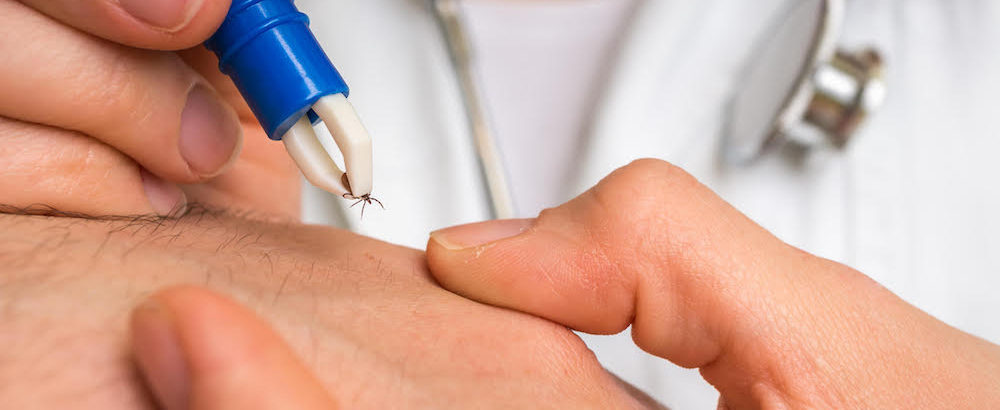By Permanente Medical Staff
Are all ticks Lyme disease carriers?
No. Lyme disease is contracted from a bite from a blacklegged tick, or deer tick, which is mainly found in the northeastern and upper midwestern United States. As the name indicates, deer are the most common hosts. Not all ticks will be infected with Lyme.
How can I prevent tick bites if I’m doing something active outside?
Wearing long-sleeved shirts and long pants while you’re in locations that are tick-friendly, like wooded and bushy areas, is your best course of action. But hot summer temperatures may make this impractical. Consider treating the clothes you do wear outside using products with 0.5 percent permethrin, which will last through several washes. For extra protection, use a repellant with 20 percent or more DEET, picaridin, or IR3535 on exposed skin.
You should also avoid areas with high grass, leaf piles, and lots of woods and brush. If you’re going hiking, stay in the center of trails when possible.
Should I be worried about ticks if I’m just spending time in my backyard?
They’re definitely still a concern, especially if you live near a wooded area or somewhere with a large deer population. Be sure to sweep any seating areas each time you plan to use the space. To cut down on the number of ticks in the vicinity, you can also apply tick-specific pesticides in your yard. However, familiarize yourself with state, local, and Environmental Protection Agency rules and regulations for using pesticides on residential property beforehand.
If you’re averse to pesticides – many people want to avoid them if they have children or pets – you can take some precautionary measures during typical lawn care. Keeping your yard clear of debris, like trash and leaves, is a great first step. Also, make sure any wood is stacked and kept in a dry place. Mow your lawn often, and be sure to keep the grasses and brush around your house and the edges of your lawn trimmed. Creating a three-foot-wide barrier between your lawn and the woods with woodchips or gravel can help, too. Go the extra mile by putting up a fence to keep wild animals out of your yard, since some can be tick carriers. Finally, set up playground equipment, decks, and patios away from the edges of your yard and the tree line.
How do I check for ticks and tick bites?
Do a full-body tick check of every family member each evening – it should only take a few minutes. Ticks tend to frequent warm, moist areas of the human body, so do close checks of the backs of knees, under arms, in and around ears, in bellybuttons, between legs, around the waist, and in hair. Shower as soon as possible after coming indoors if you can. If you brought any gear or pets with you while outside, check for any ticks that might be clinging to them, as they can later attach to a person.
I found a tick on my skin! What do I do?
First, don’t panic! Just make sure you remove it as soon as possible to lower the risk for Lyme disease – your chance of infection is higher if a tick has been feeding for at least 24 hours.
To remove it, use tweezers and grasp the tick as close to the skin as you can. Try to extract the entire tick, including its head. Pull upward, and don’t twist the tick off, which can cause the head and/or mouth to get stuck in the skin. Make sure to clean the area thoroughly once you’re done. Put the tick in alcohol, then seal it in a bag or container and wrap it tightly with tape or flush it down the toilet. If you find a tick on dry clothes, run the clothes in a high-heat dryer high heat for 10 minutes to kill it.
Next, contact your health care provider immediately. Your physician may have specific suggestions for you, depending on your individual or family’s case.
What symptoms should I look for?
The bullseye-shaped rash is the most common indicator of Lyme disease infection; 70 to 80 percent of people who contract Lyme disease will have it. Be sure to check for it throughout tick season, as you may not realize you have been bitten. It’s also important to monitor for:
- Fever/chills
- Aches and pains, including headache, fatigue, and muscle aches
- Joint pain
What should I do if I think I have Lyme disease?
Contact your health care provider. He or she may perform a blood test if, upon examination, your symptoms indicate you could have Lyme disease. If the test detects the presence of Lyme disease, you’ll be prescribed oral antibiotics that should be taken for the full course. Be sure you follow the instructions provided with your antibiotics and complete the full course of treatment.
Once you’ve had Lyme disease, the antibodies can persist in your blood long after the infection is gone. This means that if your blood tests positive, then it will likely continue to test positive for months or even years, even though the bacteria are no longer present.
With the growing deer population, Lyme disease is a concern, but this shouldn’t keep you and your family from enjoying the great outdoors. As long as you’re consistent with prevention and quick daily checks, it’s likely you can look forward to a safe summer.
For more general information about insect bites and stings, visit MAPMG’s Staying Healthy pages.




